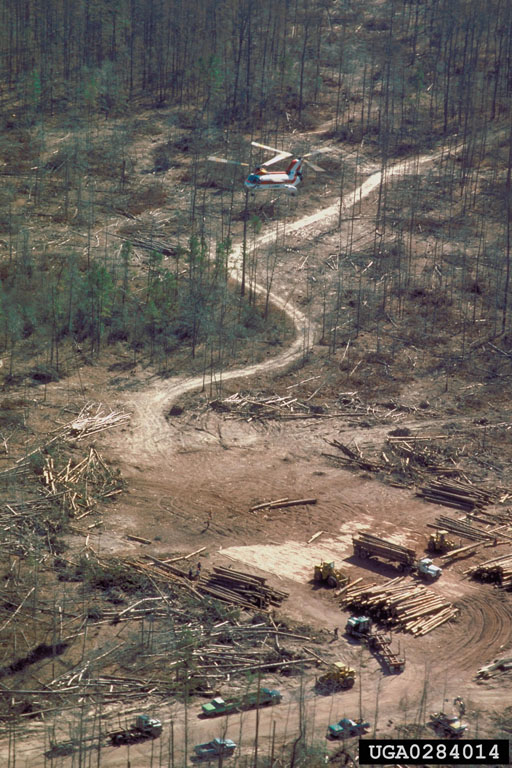|
Managers and owners usually prefer salvage removal over the
other control options because infested trees are removed from the forest and
used, giving the landowner some financial return. However, salvage of
individual spots is not always practical because of inaccessibility,
insufficient volume, poor lumber or pulpwood market, and sensitive
environmental constraints. In addition, salvage removal often takes longer
to implement than alternative tactics.
For salvage to be effective, SPB-infested material must
be removed on a timely basis. An adequate buffer strip of uninfested green
trees must also be cut around the spreading edges of the spot. Doing this
ensures the removal of freshly attacked pines that were overlooked or became
infested after the spot was initially ground checked and marked.

Procedures for Salvage Removal
Identify the spreading head(s) of the spot. The
head(s) contains the trees that have been recently attacked. They may have
green or fading foliage, fresh pitch tubes, boring dust in bark crevices or
on the foliage of understory vegetation, tight bark, and adult checkered
beetles on the bark.
Mark all SPB-infested trees or a boundary
around them if there are many trees.
If recently attacked trees are present, mark a
horseshoe-shaped buffer strip of green uninfested trees around the head(s).
The buffer should surround the recently attacked trees. A strip 40 to 70 ft.
wide will be needed for most active spots, while a 100-ft. strip (and
occasionally larger) may be needed for large, rapidly expanding spots. As a
rule, the width of the buffer should not exceed the average height of the
trees in the spot. When a spot has 10 or fewer infested trees, none of which
are freshly attacked, it normally should not be treated.

Salvage removal of infested and buffer-strip
trees should begin as soon as possible after ground checking and marking the
spot. Vacated trees can be left standing since their removal will not
contribute to beetle control. But they can be salvaged in they have not
deteriorated and the additional volume is needed to make the salvage removal
economically feasible. Choosing which trees to salvage first depends on the
season. The following priorities, in order of importance, should be followed
in salvage removal:
May-October
Trees
in the buffer zone
Trees
with fresh attacks
Remaining
trees with living brood
Vacated
trees
November-April
Remaining
trees with living brood
Trees
with fresh attacks
Trees
in the buffer zone
Vacated
trees
Infested trees should not be decked next to
green timber because emerging beetles may attack adjacent green trees.
Check salvaged spot for breakouts (new infestations
started by emerging SPB from a treated spot) during the next aerial survey.
Treat breakouts as needed.
|